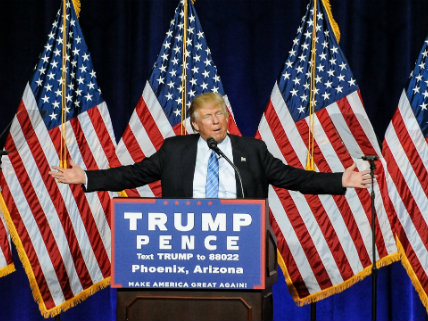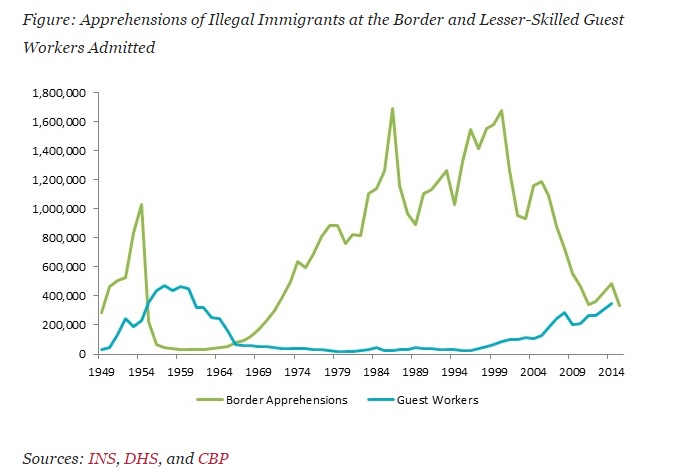Want to Reduce Illegal Immigration? You Don't Have to Build a Wall
Make new and better pathways for people to come here legally instead of creating a police state armed with biometric scanners.

Donald Trump's hard-line immigration speech on Wednesday night included plans for hiring more border patrol agents, deploying bio-metric scanners to catch illegal immigrants and establishing a new "deportation force" to round-up and eject many of the estimated 11 million people in the United States without documentation.
Of course there will also be a wall. An "impenetrable, physical, tall, beautiful, southern border wall" that would be paid for by Mexico, as Reason's Ed Krayewski reported.
Cracking down on illegal immigration is the central plank of Trump's campaign, but if he's serious about shutting down the flow of undocumented workers across America's southern border, he might want to consider an idea more radical than giant walls and an expanding immigration police force: letting more people into the country legally.
As David Bier, an immigration policy analyst for the Cato Institute, notes in a blog post this week: historically the best way to reduce illegal immigration has been to increase legal immigration. That's because one of the biggest impediments to legal immigration is the federal government's quotas on certain categories of workers. Those quotas are arbitrary totals completely disconnected from the economic forces that drive immigrants to seek work in the United States.
Those quotas "are the definition of an unreasonable immigration policy," writes Bier. "They are no different than Soviet manufacturing quotas, and they have the exact same effect: discord in the free market—surpluses where workers are unneeded, shortages where they are needed, and black markets that inevitably results when government makes movement illegal."
For example: the federal government issues about 150,000 visas annually for temporary farm workers — a number that doesn't even come close to the estimated 2 million seasonal workers on U.S. farms and ranches.
When government policy allows more lesser-skilled guest workers in the country, there are fewer illegal immigrants, Bier argues with this graphic:

In an op-ed for CNN on Wednesday, Libertarian presidential nominee Gary Johnson explained why this approach would do a better job of reducing illegal immigration than Trump's proposals (or current U.S. policy).
"Our politicians, both right and left, have created a system for legal immigration that simply doesn't work. We have artificial quotas. We have 'caps' on certain categories of workers that have no real relationship to the realities of the free market," Johnson wrote.
Instead, Johnson favors a system with no caps, no categories and no quotas. "Just a straightforward background check, the proper paperwork to obtain a real Social Security number and work legally," he wrote, calling that "a reliable system to know who is coming and who is going."
Note that he isn't calling for open borders or amnesty for illegal immigrants. People coming to the country still have to follow the rules, but he says the government should make it easier for them to do that.
Under Trump's plan (and current U.S. policy) there are essentially two groups of people coming across the border: legal immigrant and illegal immigrants. The first group is fine, but the second group consists of de facto criminals because they are breaking the law to enter the country, the argument goes.
Immigration policy requires a bit more nuance than that. Let's assume there are actually three groups of people coming across the border: legal immigrants, illegal immigrants who want to come here legally but cannot because of quotas and actual criminals who are coming to the United States to traffic drugs or fulfill any of the other fevered nightmares of the so-called Alt-Right.
Current immigration policy forces the second and third groups to cross the border illegally, but for very different reasons. Members of the second group are seeking economic opportunities and are forced into breaking the law by nonsensical government policy, but would be able to pass a basic background check under a "reliable system to know who is coming and going," like Johnson proposes. They want to be legal immigrants, and we should welcome them.
The third group is pretty small, but those are the people Trump and his fans are actually worried about. Right now, they are harder to find and stop because they are mixed in with all the illegal-but-would-prefer-to-be-legal immigrants. In a better legal immigration system, only those "criminal immigrants" would be jumping the fence—or wall, if you believe Trump will actually build one—and the border patrol (which, by the way, has been doubled in size under President Obama) could focus exclusively on them.
If Trump's supporters don't like this idea—and I suspect some of them won't—then what they are really against is immigration, period. Trump even suggested during Wednesday's speech that he would be open to further restrictions on legal immigration, saying he wanted to "reform legal immigration to serve the best interests of America and its workers."
If the goal is truly to stop the "criminal immigrants," as Trump is fond of saying, then this is the best way to sort that element out from the rest of the people coming across the border in search of a job.
If Johnson's plan were implemented, says Bier, "the days of illegal immigration would be behind us for good."
That's what Trump says he wants, right?


Show Comments (160)